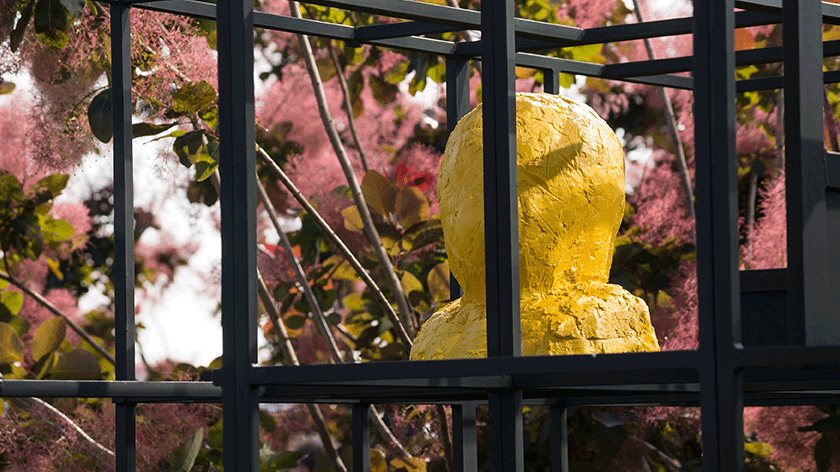No More Water
April 15–October 14, 2018
The Drift
April 15–May 20, 2018
The Heritage Centre, Lismore
Lismore Castle
Lismore
County Waterford
Ireland
Hours: Monday–Sunday 10:30am–4:30pm
T +353 58 54061
gallery@lismorecastlearts.ie
Rashid Johnson
Lismore Castle Arts is delighted to present the first major solo exhibition by Rashid Johnson in Ireland, encompassing large scale works on paper, two film works, and several new sculptural works made for the gardens.
Inspired by a childhood steeped in African American cultural influences, Rashid Johnson creates layered artworks that engage a conversation between personal biography and its relationship to larger cultural and historical narratives. Johnson works predominantly in mixed media sculptures, paintings, and drawings, combining bare materials such as mirror, wood, and shea butter with loaded iconic objects including record covers, CB radios, historical books, and common domestic objects.
For Lismore, Johnson is making a group of new sculptures employing his minimalist three-dimensional steel black grids, which will house a variety of objects including busts painted to resemble shea butter, and will act as a living greenhouse as plants in the gardens begin to intertwine with the sculpture over the summer months. The artist will also create several new sculptural works for the Upper Terrace of the Gardens, working with the Gardens team to use the sculptures as planters.
Within the gallery, Rashid responds to the vast gallery space by creating his largest drawings to date, and taking up the bulk of the main space. These new drawings explore the theme of anxiety that runs throughout the artist’s practice. The exhibition space will be book-ended by two film works, shot in 16mm and transferred to digital. The New Black Yoga (2011) and Samuel in Space (2013), explore the black male body as a site of reflection on histories past and progression towards rejuvenation and new meaning in the future.
The exhibition will be accompanied later in the summer by a fully illustrated catalogue, featuring install images of the exhibition at Lismore. The exhibition is kindly supported by Hauser & Wirth.
Maeve Brennan: The Drift
Lismore Castle Arts presents Maeve Brennan’s major new film commission The Drift (2017).
In The Drift, Brennan traces the shifting economies of objects in contemporary Lebanon. The film moves between three main characters: the gatekeeper of the Roman temples of Niha in the Beqaa Valley; a young mechanic from Britel, a village known for trading automobile parts; and an archaeological conservator working at the American University of Beirut.
Combining documentary footage, gathered through fieldwork, with staged scenes, the work depicts layered histories and communities. The Drift follows Brennan’s encounters with the gatekeeper as he recounts his life’s work restoring and guarding the temple ruins, while the mechanic crosses the Beqaa landscape, searching scrap yards for used automobile parts to transform his BMW car. Inside his workshop, the conservator slowly pieces together fragments of clay artefacts.
Forms of maintenance and repair are central to The Drift—focusing on the desire to reassemble and rebuild. Quietly underpinning the film is the urgency of archaeology in the Middle East today, particularly with reference to the destruction and preservation of heritage sites across Syria and Lebanon. Brennan’s film maps converging lines between the protected relics of ancient temples, smuggled antiquities and exchanged car parts, exploring the care, circulation and shifting value of objects.
Through observing the intertwined identities, unregulated economies and shared resistance felt across the densely layered archaeological and urban sites of Lebanon, The Drift explores the politics of conflict through its material—and immaterial—residue.
The film is produced by Chisenhale Gallery, London and Spike Island, Bristol and commissioned by Chisenhale Gallery; Spike Island; The Whitworth, The University of Manchester; and Lismore Castle Arts, Lismore.


